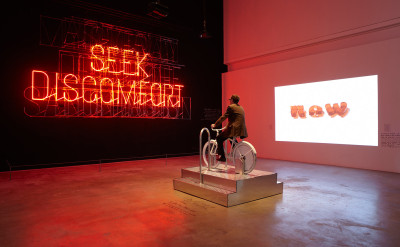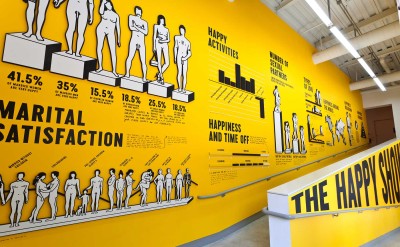Walking into Happiness:
Stefan Sagmiester’s Personal Journey
Michael David Harris
Stefan Sagmeister, “The Happy Show”
Chicago Cultural Center, July 13–September 23, 2013
 A teenage girl jumps on a rusty iron bicycle and begins rotating the pedals as fast as she can. Two of her girlfriends cheer for her. The girl goes on pedaling in place for a few minutes, waiting for the giant blue neon words in front of her to change. At this point audience members realize that pedaling on the bike changes what words are alit in this art installation. Thus far we had already seen “ACTUALLY DOING THINGS” and “I SET OUT TO DO INCREASES,” and now were staring at “MY OVERALL LEVEL OF SATISFACTION.” As the girl’s pedaling becomes arduous, and the cheers of her friends begin to wane, the security guard beside the installation suggests to the girl to, “Try pedaling hard and slow.” She does so and eventually the lighting changes to bright red neon and reads, “SEEK DISCOMFORT.” All of us experience a moment of awe before smiling.
A teenage girl jumps on a rusty iron bicycle and begins rotating the pedals as fast as she can. Two of her girlfriends cheer for her. The girl goes on pedaling in place for a few minutes, waiting for the giant blue neon words in front of her to change. At this point audience members realize that pedaling on the bike changes what words are alit in this art installation. Thus far we had already seen “ACTUALLY DOING THINGS” and “I SET OUT TO DO INCREASES,” and now were staring at “MY OVERALL LEVEL OF SATISFACTION.” As the girl’s pedaling becomes arduous, and the cheers of her friends begin to wane, the security guard beside the installation suggests to the girl to, “Try pedaling hard and slow.” She does so and eventually the lighting changes to bright red neon and reads, “SEEK DISCOMFORT.” All of us experience a moment of awe before smiling.
This installation was part of Stefan Sagmeister’s art exhibition, “The Happy Show.” Sagmeister was born in Austria in 1962 and has been working in New York City as a graphic designer since 1993. He is internationally known for designing album covers, including: “Set the Twilight Reeling” by Lou Reed, “Everything That Happens Will Happen Today” by Brian Eno and David Bryne, and OK Go’s self-titled debut album. In his graphic design work Sagmeister displays a distinct artistry through using complex colors with common objects.
“The Happy Show” is a multi-media exhibition that delves into Sagmeister’s ten-year journey to achieve ‘happiness’ and understand its meaning. The exhibition first appeared last year in Philadelphia at the University of Pennsylvania, and has since, as of this summer, traveled to Toronto, L.A., and Chicago. I attended the show at Chicago’s Cultural Center, a large neo-classical building that sets up a contrast with Sagmeister’s art. Exhibition walls in “The Happy Show” are painted a bright yellow and covered with simply-drawn persons accompanying statistics on happiness, including what countries have the happiest citizens and at what point in a relationship someone is most satisfied (and least satisfied). The exhibition also features clips from Sagmeister’s TedTalk lecture and an upcoming film based on “The Happy Show.”

At the very entrance of “The Happy Show,” Sagmeister warns that the exhibition will not make its visitors happy. Based on my experience and witnessing of others in the space, I’d claim this wasn’t entirely true. Sagmeister certainly doesn’t aim for “The Happy Show,” to be an exhibit where one’s overall joy increases, as might be the case in a playground, amusement park, or dance club. He is more interested in causing visitors to investigate why particular sights or being in certain places makes them feel happy. But with the exhibit’s theme color, graceful music, and charming comments by Sagmeister written on the walls, one can’t leave the space but with a sense of hope; hope in everyone’s capacity to overcome personal struggles and focus on the daily marvels of life.
If you leave “The Happy Show” with more hope than you went in with, it is despite Sagmeister’s pointing out all the things that don’t cause true happiness. There are also statistical graphs and figures showing how people derive limited joy from money, drugs, and passionate love. The installations sometimes even refer to the models of psychologists Steven Pinker and Jonathan Haidt to support these claims. References to science and statistics, however, probably have less impact on the visitor than Sagmeister’s bolder artistic choices. This includes giving visitors a small yellow card with his ruminations on what makes for a good life, and the presence of giant inflated balloon monkeys holding signs claiming, “Everyone thinks they are right.”
Sponsors of the exhibition advertise it as an opportunity to walk into the designer’s mind. This sounds right, as partaking in “The Happy Show” allows visitors to experience in magnificent ways things they are often told or tell themselves. This includes both making sure to do as they intend to or by sometimes seeking discomfort. Seeing such maxims physically manifested in blue or red neon can remind a spectator of their beauty or increase their faith in their power. But can partaking in such installations change the way we act and actually increase our overall wellbeing?
Sagmeister claims that part of his ten-year journey for this project was attempting to train his mind for happiness just as someone can train her or his body for fitness. There is little in “The Happy Show,” however, to support the long-term viability of training one’s mind for happiness. The best Sagmeister can do is make life suggestions, improving the likelihood of spectators ability to be happy. The most interesting of his suggestions is to choose to take five years off from retirement and insert a year of free time for every seven years spent working. Some may not utilize this year to improve personal relations or master a hobby, but it’s better when people have more free time, and therefore chances to be happy. Similarly, the hope that “The Happy Show” provides its participants may not result in happiness, but with simple maxims and with the power of design it increases their chances of getting there.

Michael David Harris is a recent graduate of Emory University, where he studied philosophy and religion. He was born and currently lives in Chicago.

0 comments on “Review: Stefan Sagmeister”